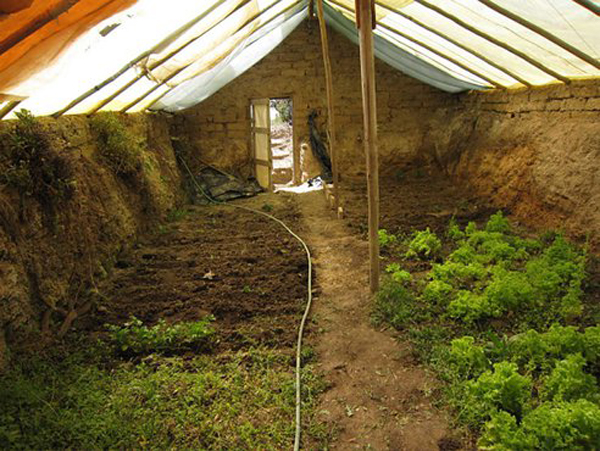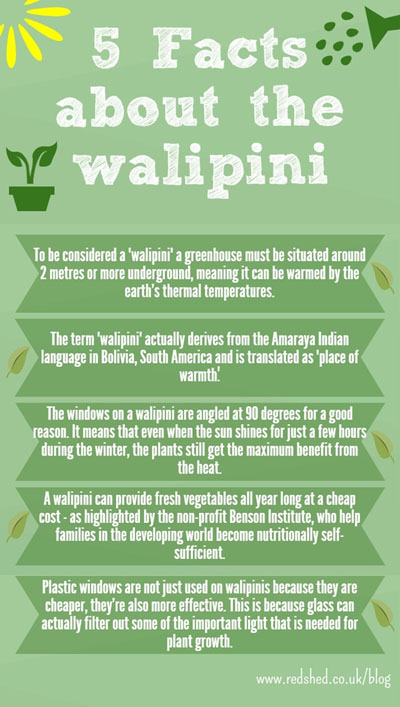
“Growers in colder climates often utilize various approaches to extend the growing season or to give their crops a boost, whether it’s coldframes, hoop houses or greenhouses.
Greenhouses are usually glazed structures, but are typically expensive to construct and heat throughout the winter. A much more affordable and effective alternative to glass greenhouses is the walipini (an Aymara Indian word for a “place of warmth”), also known as an underground or pit greenhouse. First developed over 20 years ago for the cold mountainous regions of South America, this method allows growers to maintain a productive garden year-round, even in the coldest of climates.
This earth-sheltered greenhouse taps into the thermal mass of the earth, so that much less energy is needed to heat up the walipini’s interior than an aboveground greenhouse. Of course, there are precautions to take in waterproofing, drainage and ventilating the walipini, while aligning it properly to the sun — which the manual covers in detail.”
Read more at the source: Treehugger.com
And here is an infographic about Walipini from redshed.co.uk/blog:


Hello
We are creating a typology to promote urban and per-urban food growing – we’d like to use the Walipini greenhouse blog as an exsample of growing in colder climates. That would simply mean adding your hperlink as a case study. Hope that’s ok with you? Best wishes
That is fine with me.
Help
I wanna build one, but need help
I have seen something similar called trench gardening where basically you dig a trench waist high two rows of plants and a path wide and use pvc pips and 6 mil plastic to create a cold house to extend the growing season. this looks like it is similar just done larger and deeper either way a welcome addition to any garden in my opinion.
That’s a good idea. I’ve seen this a hoop house like this with curved PVC pipe. The earth helps stabilized the internal temperature. There was a path down the center and a partially raised bed on each side (midheight between the bottom of the path and ground level). I just realized though that these hoophouses could be made just like the pit greenhouse, but on a smaller scale. That way you could experiment with the design before making a big one.
Good suggestions. Good advice. Good blog.
Well, the price is right. Hard to beat free. And you can save a lot of time searching for info, because we aggregate lots of related content in one place.
The $300 price tag is what first caught my attention. Then I started reading the comments at Treehugger.com and realized there are many possible options to enhance the basic design. Take for example a cold climate in the northern hemisphere:
– animals inside
– large compost pile (built so maximum heat is released in the middle of winter)
– steeper roofs (adjust angle to your area)
– use the excavated earth to raised the surrounding site
– building a shallower pit greenhouse might be best in areas with reduced sunlight
– rigid panels in snow country
– wood stove inside or any of the stoves on our blog such as sawdust stoves https://naturalbuildingblog.siterubix.com/sawdust-stoves/
– possible PEX radiant floor heat in very cold climates (costly, but think how much healthy food you could grow and the price of food nowadays) ex: Endless Hot Water Without Electricity https://naturalbuildingblog.siterubix.com/endless-hot-water-without-electricity/
– black water barrels on back wall
– earthbag walls versus rammed earth
– aquaponics
– plants on benches to raise them off the cold floor
– trench to drain cold air
– retractable insulated curtains for nighttime
– grow lights if necessary in far northern climates
– reflective material (foil covered insulation) on north part of roof
– PAHS system around the house https://naturalbuildingblog.siterubix.com/pahs-principles-explained/
– roof water collection with storage tanks inside the greenhouse or buried under the floor
– terraced planters that gradually step up toward the back wall so plants get maximum sunlight in winter
– hanging plants
– temperature actuated fans and possibly roof vents that kick on when it gets too hot
– automatic misters that reduce hand watering
One commenter said these pithouses are very popular in China. Some owners have dozens or even hundreds. This sounds ideal for a home based business in the right climate. The price of food is particularly outrageous in the far north. You shouldn’t have any trouble selling fresh organic produce at a nice profit as well as feeding your family for peanuts.
Hire a local designer if necessary. The money would be well spent if the greenhouse is optimized. Local designers will know your water table, rainfall, latitude, solar angles, snow loads, wind loads, climate cycles, soil conditions, codes, etc. This would be a great project for architecture students. Put your training to use and then open source it. Before long there could be dozens of open source designs to choose from.